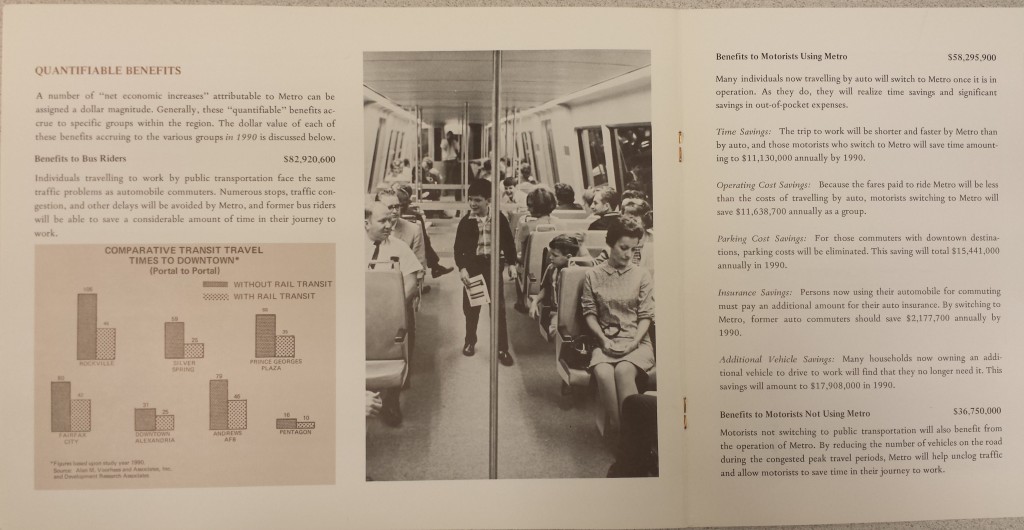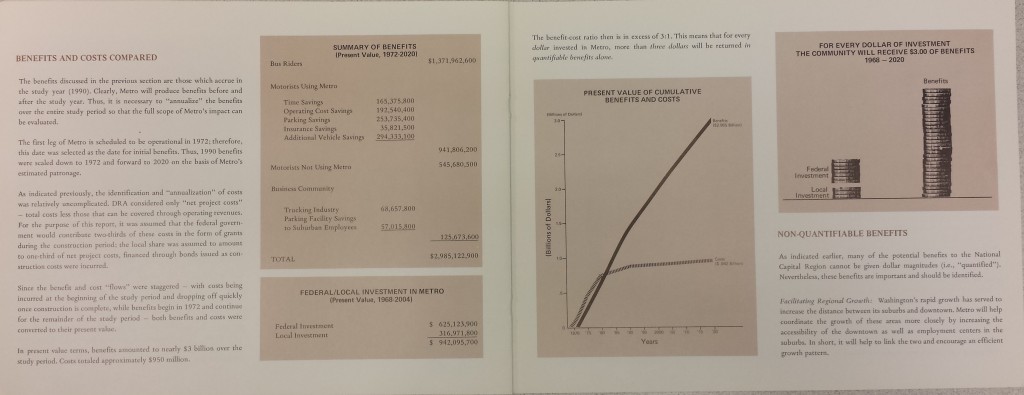Does Transit Yield its Promised Economic Benefits? A 1969 Perspective.
The actual economic benefits of Metro far exceed what planners estimated in 1969, and it’s worth remembering as we consider future transit investments.
In the late 1960s, when Metrorail was nearly about to begin construction, Metro published a forecast of the economic benefits of Metrorail. The report made rosy projections of the all the travel time and costs the network, then a 97-mile proposed rail system, would bring. (It also included photos of the pretty awesome 3-D model of a station, including maybe a one-car train?). Now, four decades later, were the projections right? Has Metrorail produced the benefits we thought? The answer is yes, and then some.
At the time this report came out, the region was about to make a substantial investment in public transit , probably not unlike today, where we face real choices about whether to invest in Metro 2025 initiatives such as 8-car trains, the Purple Line, or bus lanes. To quote the report,
Metro is ready for construction. The routes have been selected. The program for local financing has been approved.
How feasible is Metro? Who will benefit? Will the benefits justify the costs? Is Metro a good public investment for the National Capital Region and its financial partner, the federal government?
The report tallied up all the time savings to riders – former motorists, former bus riders, and truckers – as well as the travel cost savings like avoided parking, vehicle savings, operating cost savings, and more. It concluded that Metro would save $186 million per year in 1990$, roughly equivalent to $310 million/year in today’s dollars after adjusting for inflation.
Did this turn out to be correct? Our 2011 Making the Case for Metro study posed a very similar question, and estimated the same economic benefits of Metro (travel time, costs) in 2011 at just over $1 billion/year – about three times higher than the estimate from the 60s. There are some apples-to-oranges going on here, most notably that the 1969 study quantified the benefits of Metrorail alone, whereas the 2011 study included Metrobus. And Metrorail in 2011 was a bit bigger than 97 miles. But nevertheless, the current benefits still outweigh the 1969 study. Interestingly, the study also predicted that the cost of Metrorail would be just under $1 billion (in 1969 dollars) – significantly less than the actual construction costs, but the difference in costs is roughly similar to the difference in benefits.
In 1969, “30% of downtown-destined commuters travel by public transportation. This is unique for a city without rail transit.” Today, with Metrorail, that share is up to 51% according to COG/TPB Cordon Counts (PDF), even as the city has grown significantly.
Forty years ago, this region was considering a massive investment in transit, and the actual benefits have exceeded the forecasts at the time. As we consider the costs and benefits of further transit investments, it is important to keep this in mind.






The gardener ought to be careful never to fill the soil
and amendments greater than 25 percent on the top tier
in the border. The Terrier Group includes those small but lively terrier breeds that
have been developed (mainly in Great Britain) to hunt
small burrowing animals such as badgers, foxes, otters, rabbits and rats.
Given their domineering streak, Jack Russells may wish to challenge other dogs that they think are having the attention they deserve.